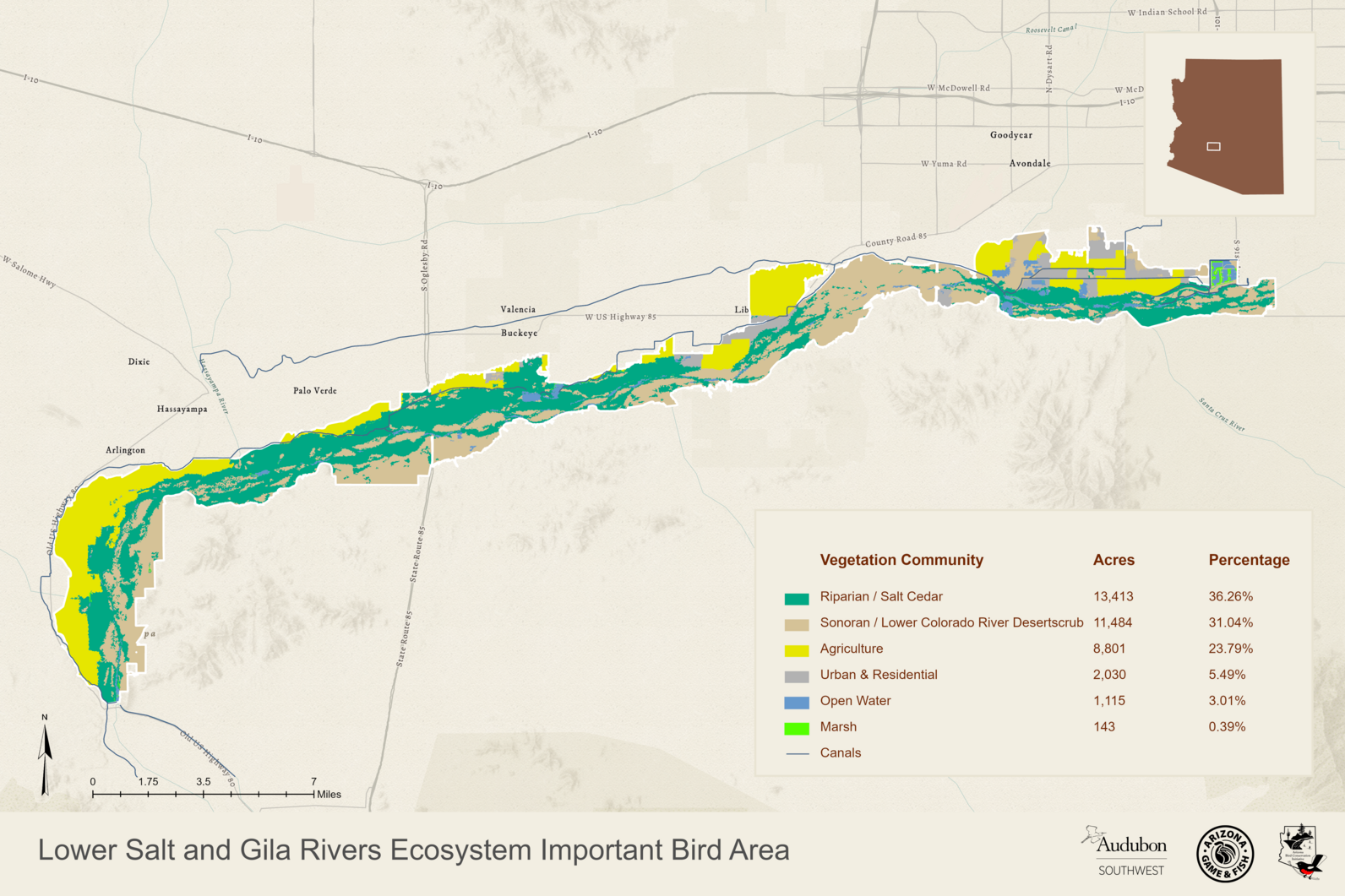Audubon Southwest Director of Bird Conservation discusses the importance of revitalizing the Lower Gila River corridor
Pronounced “He La,” the Gila Rivers’ headwaters originate in New Mexico, where it is a wild and scenic mountain river. The path of the Gila settles into broad valleys as it enters Arizona, providing water for rural towns and agriculture along the way. The Gila’s flow is interrupted by Coolidge Dam and San Carlos Reservoir on the San Carlos Indian Reservation west of Safford, Arizona. Water from the reservoir is managed by the San Carlos Irrigation District for communities, farms, and ranches downstream. The Ashurst-Hayden and Florence diversion dams in Pinal County send what remains of the Gila River water to Central Arizona farms, after which the river is a dry channel except when there are high flows from rain and snow melt.
The combination of dams, diversions, and drought earned the Gila River the title of Most Endangered River in 2019 from American Rivers, a nonprofit advocacy organization.
History
In the 1800s, upstream diversions of the Gila River by settlers severely impacted the Akimel O’odham and Pee-Posh —Indigenous people who resided along the Gila River for centuries before the arrival of Euro-Americans. Today, the Akimel O’odham and Pee-Posh people form the Gila River Indian Community. After years of negotiations, they now receive Colorado River water delivered from the Central Arizona Project (the 336-mile-long canal that brings Colorado River water to Maricopa, Pinal, and Pima Counties) as part of a water rights settlement to restore part of what they lost when the Gila River dried up through their homeland.
Revitalization
Where the Gila River meets the Salt River, west of Phoenix on the northern edge of the Gila River Indian Community, the Gila can be called a “river” once again. The Gila River Indian Community is planting native trees at the Pee Posh wetlands near the City of Phoenix’s Tres Rios Ecosystem Restoration Area. The 91st Avenue Wastewater Treatment Plant purifies wastewater and returns it to the Salt River at 91st Avenue west of Phoenix. From there, it flows into the Gila River. This length of river is a wildland oasis with marshes and forests of cottonwoods and willows. Yuma Ridgway’s Rail and Western Yellow billed Cuckoos, federally endangered and threatened birds, breed here. In addition to creating habitat for wildlife, the Pee Posh wetlands and Tres Rios Ecosystem Restoration Area filter water naturally, reducing pollutants and removing sediment from the water. The National Audubon Society in partnership with the Arizona Game and Fish Department designated the lower Salt and Gila Rivers from the Tres Rios Ecosystem Restoration Area to Gillespie Dam to the southwest as a globally Important Bird Area (IBA).

Important River Corridor
The Important Bird Area and adjacent communities and farmlands are the location of the Lower Gila River Collaborative, the western part of Rio Reimagined, a visionary revitalization plan for the rivers. The Environmental Protection Agency (EPA) has designated the Rio Reimagined river corridor as an Urban Waters Federal Partnership, and the U.S. Fish and Wildlife Service has identified the region as an Urban Wildlife Partner.
Lower Gila River Collaborative
The Lower Gila River Collaborative began as a partnership among the communities of Avondale, Goodyear, Buckeye, and Phoenix, Maricopa County Parks and Recreation Department and Flood Control District, Arizona Game and Fish Department, and Buckeye Water Conservation and Delivery District. It formed, in part, to address the invasive salt cedar (also known as tamarisk) that grows in the river channel and adjacent terraces. The collaborative has completed a strategic action plan that includes recreation, restoration of native plants in the river and economic development. Audubon Southwest is a partner co-chairing the habitat enhancement working group with the Arizona Game and Fish Department. Gila River Indian Community and the U.S. Fish and Wildlife Service are also members of the collaborative’s Leadership Council.
Results
Audubon Southwest advocated for funding to help with the restoration of the Salt and Gila rivers in this area. And thanks to that funding, provided by the Arizona state legislature and federal grants, the Arizona Department of Forest and Fire is implementing salt cedar removal and native tree planting at key locations in the river corridor. Maricopa County Estrella Park has planted a pollinator garden and re-treated an earlier salt cedar project in the river. The City of Buckeye, the Flood Control District of Maricopa County, Arizona Game and Fish Department, and the U.S. Fish and Wildlife Service have all completed salt cedar removal projects. Combined, the acres restored continue to grow.
Take a virtual tour of the river here.


